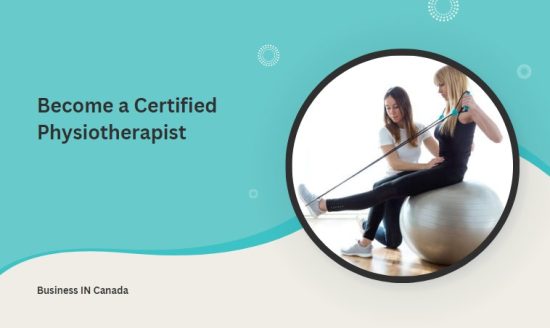Are you interested in pursuing a career as a physiotherapist in Canada but don’t know where to start? Look no further! In this complete guide, we will walk you through the steps on how to become a licensed and certified physiotherapist in Canada. From completing your Bachelor’s degree to gaining practical experience, we have got everything covered.
So, whether you’re just starting or looking for ways to advance your career path, keep reading and learn how to make your dream of becoming a physiotherapist come true!
Who is Physiotherapist?

Physiotherapists, also known as physical therapists, are healthcare professionals who specialize in helping individuals who have suffered from injuries or illnesses that affect their mobility and function. They use various techniques and exercises to help patients regain strength, flexibility, balance, and coordination and reduce pain.
Physiotherapists work with people of all ages, including infants and children with developmental problems. They provide treatment for conditions such as sports injuries, chronic pain management, and neurological disorders like stroke or Parkinson’s disease.
In addition to treating existing conditions through various therapies such as massage therapy or ultrasound stimulation, they also teach patients proper exercise techniques to prevent further injury and maintain overall health & well-being.
It is important for physiotherapists to have strong communication skills as they often need to explain complex medical terms or procedures in simple language that the patient can easily understand. With their expertise in anatomy and physiology coupled with an empathetic approach towards patient care – Physiotherapist plays a vital role in restoring movement and independence among their clients.
What Does Physiotherapist Do?
Physiotherapists are healthcare professionals who specialize in diagnosing, treating, and preventing physical impairments, disabilities, and pain. They work with patients of all ages to help them regain movement and function after an injury or illness.
One of the main tasks of a physiotherapist is to assess their patient’s physical abilities and limitations. This involves evaluating their range of motion, strength, flexibility, posture, balance, coordination, and overall fitness level. They establish a specific treatment plan based on the results of this assessment, which may include exercises to increase strength and mobility.
In addition to exercise therapy, physiotherapists also use other techniques such as manual therapy (massage), electrical stimulation (TENS), and heat or cold packs to relieve pain and inflammation.
Another important aspect of a physiotherapist’s job is educating patients about how to manage their condition at home through proper exercise techniques and activity modification.
A physiotherapist’s goal is to help patients achieve optimal health by improving mobility and functional ability and reducing pain, thus restoring quality of life for all age groups.
How to Become Physiotherapist in Canada?

Becoming a physiotherapist in Canada requires dedication, hard work, and a passion for helping others. Therefore, having the right education, training, and certifications is important to qualify as a licensed physiotherapist.
To become a registered physiotherapist in Canada, you will need to complete an undergraduate degree program with specific prerequisites before applying for admission to an accredited Master or Doctoral level program in Physiotherapy. After completing your degree program and acquiring all required certifications and licenses, you can then apply for registration through the regulatory authority of the province you wish to practice in.
By following the steps outlined above on becoming a physiotherapist in Canada, you can pave your way toward building a successful career that involves improving people’s lives by providing them with expert physical therapy services.
Complete a Bachelor’s Degree
Completing a bachelor’s or university degree is the first step toward becoming a physiotherapist in Canada. Choosing a program that will provide you with the necessary prerequisites for applying to a Doctorate of Physiotherapy (DPT) program is important.
There are many universities across Canada that offer undergraduate programs in kinesiology, health sciences, or biology, which can be great options to fulfill those prerequisites. Remember that some DPT programs may have specific requirements beyond what is offered within these degrees, such as anatomy, physiology and biomechanics courses.
It is also important to note that admission into DPT programs can be competitive, so it’s essential to maintain good grades throughout your undergraduate studies and gain relevant experience through volunteering or shadowing opportunities.
Completing an undergraduate degree lays the foundation for success as a future physiotherapist in Canada by providing valuable knowledge and skills required for further education and practice.
Earn a DPT

After completing a bachelor’s degree, the next step to becoming a physiotherapist in Canada is to earn a Doctor of Physical Therapy (DPT) degree. This program typically takes 3-4 years to complete and provides students with an in-depth understanding of the human body, movement science, and rehabilitation techniques.
Students will take anatomy, physiology, pharmacology, kinesiology, and musculoskeletal dysfunction courses during their DPT program. They will also participate in clinical rotations where they gain practical experience working with patients under the supervision of licensed physical therapists.
In order to be accepted into a DPT program in Canada, applicants must have completed specific prerequisites, which vary by university but generally include courses in biology and chemistry. Additionally, most programs require applicants to submit GRE scores and letters of recommendation.
Earning a DPT is essential to becoming a licensed physiotherapist in Canada. The rigorous coursework combined with hands-on clinical experience prepares graduates for successful careers helping patients recover from injuries or illnesses that affect their mobility and functionality.
Get a License to Operate as Physiotherapist
After completing your Doctor of Physical Therapy (DPT) program and residency, the next step to becoming a physiotherapist in Canada is obtaining a license to operate. This is an important requirement that ensures you are qualified and competent enough to practice as a physiotherapist.
The licensing process involves fulfilling regulatory requirements set by the Canadian Alliance of Physiotherapy Regulators (CAPR). In addition, you will need to submit your academic transcripts, complete a written exam, and undergo clinical assessments. The exam tests your knowledge of different aspects of physiotherapy, such as musculoskeletal, neurology, and cardiopulmonary.
Once you have successfully passed all the exams and met all other regulatory requirements, you will be granted permission to practice as a licensed physiotherapist in Canada. It’s crucial for every aspiring physiotherapist should obtain this license before practicing because it ensures that they meet high standards of professionalism and competence.
Remember that maintaining your license requires continuing education courses throughout your career. By doing so, you can keep up with new developments in technology or best practices within the field, which ultimately enhances patient care outcomes.
Complete Residency

Completing a residency is an essential step in becoming a certified physiotherapist in Canada. During the residency, you will gain hands-on experience under the guidance of experienced professionals and work with patients to apply your classroom knowledge.
The length of a residency program may vary depending on the type of setting you choose. A hospital-based residency typically lasts for 12 months, while community-based programs may last up to two years.
During your residency, you’ll have the opportunity to work with various patient populations, such as elderly people or athletes. You might also get exposure to different specialties like neurology or pediatrics. This allows you to develop your skills and expertise in specific areas that interest you.
Most residencies require you to complete rotations across different settings, including outpatient clinics, hospitals, and rehabilitation centers. This provides valuable exposure to diverse clinical environments.
Residency programs often include ongoing evaluations of your progress by supervisors who provide feedback regularly. This ensures that residents remain competent throughout their training period.
Completing a residency is an excellent way for aspiring physiotherapists in Canada to hone their practical skills and gain firsthand experience working with patients across different settings and specializations.
Become a Certified Physiotherapist

Once you have completed your residency and obtained a license to practice as a physiotherapist, the next step is to become certified. Certification is not mandatory but can enhance your professional credibility and increase job opportunities.
To become certified in Canada, you must pass the Physiotherapy Competency Examination (PCE), which assesses whether you possess the necessary knowledge and skills to practice safely and effectively. The PCE consists of two parts: written and clinical components.
The written component tests your understanding of fundamental concepts such as anatomy, physiology, pathology, assessment techniques, treatment interventions, ethics and law. The clinical component evaluates your ability to apply these concepts in real-world scenarios through practical simulations and case studies.
Preparing for the PCE requires dedication and hard work. You may need to review course materials from your DPT program or enroll in additional post-graduate courses or workshops. Practice exams can also help familiarize yourself with the format of the test.
Passing the PCE demonstrates that you meet national standards for entry-level physiotherapy practice in Canada. It signifies that you are competent to provide safe care for patients across various settings, including hospitals, clinics, private practices or sports teams.
Becoming certified marks an important milestone towards establishing yourself as a fully qualified therapist with specialized skills that can benefit patients in need of rehabilitation services.
Conclusion
As we come to the end of this comprehensive guide on how to become a physiotherapist in Canada, it’s important to note that the journey toward becoming a certified physiotherapist can be challenging but ultimately rewarding. It requires hard work, dedication, and commitment.
Throughout this article, we have outlined the steps you need to take in order to become a licensed physiotherapist in Canada. Each step is crucial for success, from completing your Bachelor’s degree and earning a DPT to obtaining your license and completing residency training.
However, it’s important to remember that certification doesn’t end with becoming a physiotherapist. As healthcare professionals, we must continue learning throughout our careers by staying up-to-date with advancements in research and techniques.
Ultimately, being a successful physiotherapist means having compassion for patients while providing them with quality care. It means being able to adapt treatment plans based on individual needs while maintaining professionalism at all times.
Suppose you are passionate about helping people improve their physical health and well-being through hands-on therapy techniques. In that case, pursuing a career as a physiotherapist may be right for you!
FAQ – How to Become Physiotherapist in Canada?

How long does it take to become a physiotherapist in Canada?
Becoming a physiotherapist in Canada involves both academic and practical training. Typically, it takes about six to seven years to complete the necessary education and obtain the required certification.
Firstly, students are required to complete a Bachelor’s degree program that includes specific courses in anatomy, physiology, biology, psychology and kinesiology. Typically, four years of full-time education are required.
After obtaining their undergraduate degree, students must enroll in a Doctor of Physiotherapy (DPT) program that typically lasts two or three years. In this program, they will receive advanced clinical training through classroom lectures and hands-on practical experience.
Upon completing their DPT program, graduates must pass a licensing exam administered by the Canadian Alliance of Physiotherapy Regulators (CAPR). Once licensed by CAPR, graduates can legally operate as physiotherapists in Canada.
Most provinces require newly graduated physiotherapists to complete a residency program under experienced professionals before becoming certified practitioners themselves.
It is clear that becoming a qualified physiotherapist requires dedication and time, but with hard work and determination, one can successfully achieve their goal!
How do I start a physiotherapy career in Canada?
Starting a career in physiotherapy is an exciting and rewarding journey. However, it can also be overwhelming if you don’t know where to begin. Here are some steps to help you start your physiotherapy career in Canada.
Firstly, research the different universities that offer Bachelor’s degrees in Physiotherapy. Look into their dates for applications and admittance standards. Choosing a program that aligns with your interests and goals is important.
Once accepted into the program, focus on building strong academic foundations by studying anatomy, physiology, biomechanics, kinesiology and other related subjects.
During your studies, take advantage of opportunities to gain practical experience through internships or volunteer work at clinics and hospitals.
After completing the Bachelor’s degree program successfully, enroll in a Doctorate of Physical Therapy (DPT) program accredited by The Canadian Council of Physiotherapy University Programs (CCPUP).
Upon graduation from DPT programs which will last for three years, apply for licensure/registration with the regulatory body governing physical therapy practice within your province/territory of choice.
Continue honing your skills by attending workshops and conferences regularly throughout your career, as continuing education is essential to maintain registration/license as well as enhancing clinical expertise.
How long does it take to be a fully qualified physiotherapist?
Becoming a fully qualified physiotherapist in Canada is a process that requires dedication and commitment. The length of time it takes to become fully qualified can vary depending on the education path you choose. Typically, it takes 6-7 years of post-secondary studies to be considered a fully qualified physiotherapist.
To start, you must complete an undergraduate degree, which usually takes four years. After completing your undergraduate degree, you must earn a Doctor of Physical Therapy (DPT) degree. This program typically lasts 2-3 years.
Once you have earned your DPT degree, you must obtain a license from the regulatory body in your province or territory before practicing as a physiotherapist. This process may take anywhere from several weeks to several months.
After obtaining your license, completing residency training is also required for some provinces or territories in Canada. A residency program can last between one and two years and provides additional clinical experience under the guidance of experienced professionals.
In summary, becoming a fully qualified physiotherapist in Canada requires completing an undergraduate degree followed by earning a DPT degree and obtaining licensure from the regulatory body in your province or territory. Completion of residency training may also be necessary, depending on where you plan to practice as a physiotherapist.
Do I have to go to med school to be a physiotherapist?
Becoming a physiotherapist in Canada does not require attending medical school. However, it does entail completing several years of post-secondary education and obtaining the necessary licenses and certifications.
To begin, aspiring physiotherapists must complete a Bachelor’s degree in a related field, such as kinesiology or health sciences. This typically takes four years to complete and provides students with foundational knowledge about human anatomy, physiology, and biomechanics.
After completing their undergraduate degree, students must then earn a Doctor of Physical Therapy (DPT) from an accredited program. This usually takes three years to complete and involves coursework in clinical practice, patient care management, research methods, and more.
Once they have obtained their DPT, graduates must obtain licensure through their province’s regulatory body for physical therapists. They may also choose to pursue additional training through residency programs or certification by professional organizations like the Canadian Physiotherapy Association.
While becoming a physiotherapist requires significant education and training beyond high school graduation, attending medical school is unnecessary to achieve this career goal.
Which course is best for physiotherapy in Canada?
When it comes to choosing the best course for physiotherapy in Canada, several universities offer excellent programs that can equip students with the skills they need to succeed in their careers. Some of these institutions include the University of Toronto, McGill University, Queen’s University, Western University and many others.
Ultimately, what makes a course great for you depends on your needs and preferences. So take some time to research different options before making your decision. With hard work and dedication throughout your education and training process, coupled with a passion for helping people through physical therapy services, you can become an excellent physiotherapist ready to positively impact the lives of patients who seek help from you!










